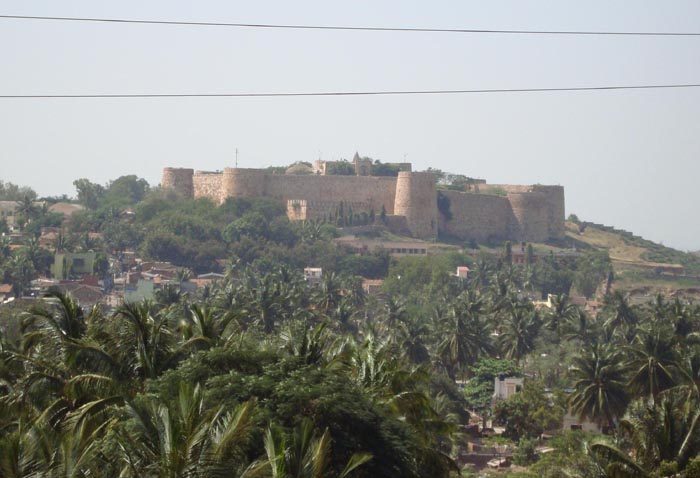Saundatti Fort

Information on Saundatti Fort (Belgaum, Karnataka) - History & Architecture
Saundatti Fort is situated within a distance of about 78 kilometre from Belgaum city of Karnataka. It is basically a Taluq which was traditionally termed as Parasgad. Saundatti Fort is a historical site which is characterised by many temples with various captions. It also possesses a water reservoir which has been formed by Navilathirtha dam on Malaprava River. Saundatti Fort is particularly congested during the promising event of 'Bharathi Hunime' and 'Banada Hunime'.
Saundatti Fort Architecture
Saundatti Fort is also termed as Savadatti Fort. The most interesting feature of this fort is the existence of various temples. Among them, the most popular temple is Renuka temple, also known as Yellamma temple. Moreover, the fort is also popular for the fair which is organised in the temple namely Yellamma Jatre. The temple is devoted to lord Shakti.
There is another popular temple inside Saundatti Fort namely Puradeshwara temple. It possesses two faced structure and three pillared outdoor halls. The temple was created in Western Chalukya architectural style. The structure over the sanctum is created from Kadamba architectural style. However, at present the structure is in ruined condition. The main hall of the temple is enclosed by polished columns. The niches are decorated with statues of lord Parvati and lord Veerabhadra. The temple also has a Shiv Linga. It is worth mentioning that every shrines inside Saundatti Fort have statues of Shiv Lingas. Furthermore, during the New Year day of Deccan calendar, the sunlight directly fall on the Shiv Linga of Puradeshwara temple. The temple has recently being refurbished.
Ankeshwara temple is the other temple resided underground of Saundatti Fort. There are steps inside the underground channel which lead to a public pavilion. This temple was created by Ratta dynasty in 11th century and also based on Western Chalukya architectural style.
Saundatti Fort possesses eight mainstays and accommodates Kadasideshwara temple. This temple is enclosed by four mainstays. The inner caves of this temple possesses rows of statue with various symmetrical designs. Apart from these, there are various other temples in Saundatti Fort such as Puradeshwara, Nagarkere Ankeshwara, Ulvi Basavaeshwara, Mouneshwara and Dyamavva among others. Each temple have different structures with various architectural designs.
Saundatti Fort History
Saundatti area was regarded as the capital of Ratta dynasty during 9th century to 13th century. Afterwards, the capital moved to Belgaum. Saundatti Fort was created in 10th century by Shirasangi Desai and planned by Bichiraja of Ratta family. They have accepted the location of Saundatti area in order to create the fort during 973 AD to 977 AD. Two of the columns of the fort possesses South Dravidian captions and one caption dates back to the year 1199 which signify the date of the creation of the fort. It is accredited to Ratta ruler Kartaveerya. Through research, another two captions have been discovered in the fort where one caption is written in Sanskrit language, the other written in Kannada style. One caption signify the sovereignty of Rashtrakuta rulers while the other is accredited to Ratta king, Ankarasa. Historical records also depict that most of the Ratta kings belong to Jain.
Saundatti Fort Tourism Importance
Saundatti Fort is a holy place and is quite popular for the purpose of tourism. The number of temples inside Saundatti Fort attracts various tourists who are devoted to god. Travellers from Karnataka, Andhra Pradesh and Tamil Nadu among others appear here every year in order to worship. Additionally significant number of people also come during the event of Yellamma Jatre. On the other hand, throughout the event of 'Bharathi Hunime' and 'Banada Hunime', the congregation of Saundatti area surpasses about 1 million.
- Bangalore Monuments
- Bagalkot Monuments
- Belgaum Monuments
- Bellary Monuments
- Bidar Monuments
- Bijapur Monuments
- Chitradurga Monuments
- Coorg Monuments
- Dakshina Kannada Monuments
- Gadag Monuments
- Gulbarga Monuments
- Hassan Monuments
- Mysore Monuments
- Raichur Monuments
- Uttara Kannada Monuments
- Yadgir Monuments
- Andaman Nicobar Monuments
- Andhra Pradesh Monuments
- Assam Monuments
- Bihar Monuments
- Chhattisgarh Monuments
- New Delhi Monuments
- Goa Monuments
- Gujarat Monuments
- Haryana Monuments
- Himachal Pradesh Monuments
- Jammu and Kashmir Monuments
- Karnataka Monuments
- Kerala Monuments
- Madhya Pradesh Monuments
- Maharashtra Monuments
- Odisha Monuments
- Punjab Monuments
- Rajasthan Monuments
- Tamil Nadu Monuments
- Telangana Monuments
- Uttar Pradesh Monuments
- West Bengal Monuments